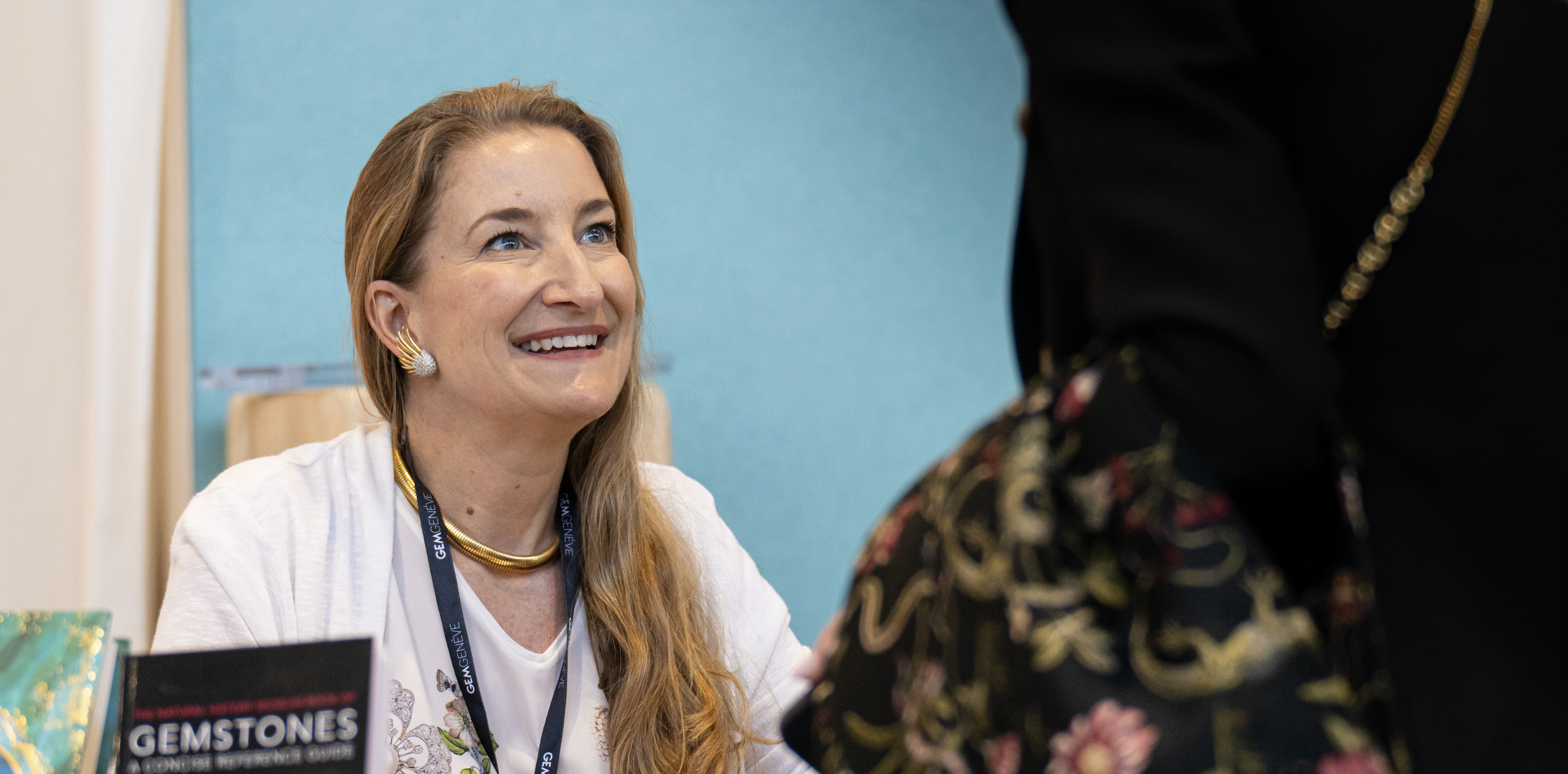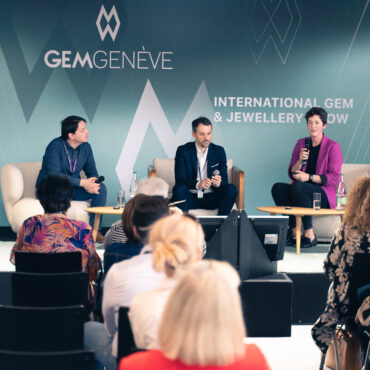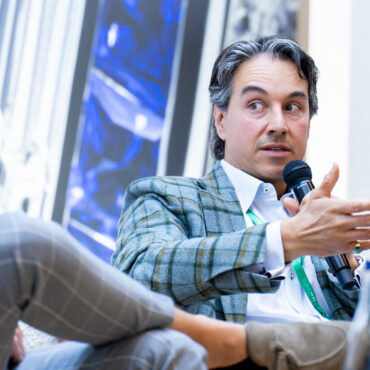The “Hidden Gems – Secrets of the Museums” conference, held at GemGenève, was an enthralling event featuring Robin Hansen, Curator of Minerals and Gems at the Natural History Museum in London, and Helen Molesworth, Senior Curator of Jewellery at the Victoria and Albert Museum in London. This session provided a captivating dive into the world of gems, jewels, and the rich histories behind some of the most exquisite pieces housed in these prestigious institutions. The engaging narratives presented by both curators highlighted the intrinsic and historical value of these precious artefacts, making the session equally enlightening for experts and enthusiasts alike.
Helen Molesworth commenced the event by introducing herself and Robin Hansen. They both shared their personal journeys into the world of gems and minerals, highlighting their deep-rooted passions influenced by their parents. Helen’s fascination with jewellery began through her love for archaeology and her father’s suggestion to pursue what made her happy. This led her to Sotheby’s and Christie’s, where she spent a decade handling aristocratic and royal jewels before achieving her dream role at the V&A. Robin, on the other hand, was inspired by his mother’s interest in geology, which eventually led him to the Natural History Museum, where he now oversees a collection of over 200,000 specimens. This initial personal insight set the stage for a series of enthralling tales and discoveries.
The conference featured a dynamic discussion between Helen and Robin, who shared stories behind some of their favourite pieces in their respective collections. Robin showcased a stunning morganite gem, considered one of the largest flawless faceted morganites in the world, weighing just under 600 carats. This gemstone, named after the American banker and gem collector J.P. Morgan, was acquired by the museum in 1913 and is noted for its remarkable size and clarity. Morganite, first discovered in Madagascar in 1910, quickly became a prized addition to the museum’s collection, possibly cut from the rough of the original find. This morganite’s immense size and flawless nature make it a standout piece within the collection, highlighting the extraordinary skill and precision required to transform such a large crystal into a perfectly faceted gem.
Helen highlighted the Imperial Topaz from the Londonderry Jewellery Collection, a spectacular 170-carat gem with a deep pinkish-purple hue. This piece originally belonged to Frances Anne Vane Stewart, whose jewels were a testament to her significant social standing and connections, including a friendship with the Tsar of Russia. The Londonderry Topaz, prominently featured at the V&A in the Bollinger Jewellery Gallery, was complemented by a vivid yellow diamond gifted by the Tsar. Helen shared amusing anecdotes about the Londonderry Tiara, which once ended up lodged in a toilet at Buckingham Palace, illustrating the colourful and sometimes humorous history behind these magnificent pieces. The tiara’s misadventure in the palace toilet is a testament to historical jewels’ unpredictable and often amusing life.
The discussion also touched on the fascinating world of padparadscha sapphires, known for their unique pinkish-orange colour. Robin explained the scientific intricacies behind the colour variations in these gems. At the same time, Helen elaborated on the historical and cultural significance of their names and the ongoing debates about their precise definitions. Padparadscha, derived from the Sinhalese word “padmaraga,” meaning lotus-coloured stone, is the only type of sapphire with its own distinct variety name, highlighting its special place in the gem world. With its blend of pink and orange hues, this unique gem type symbolises the delicate balance of nature’s beauty, further enriched by the romantic description likening its colour to a lotus blossom at sunset.
In addition to these remarkable gemstones, the conference delved into the intriguing tales of cursed gems. Robin recounted the story of the “cursed amethyst,” looted from a temple in India and believed to bring misfortune to its owners. Now housed in the Natural History Museum, this amethyst came with a letter warning of its dangerous past. The stone had brought misfortune to everyone who owned it, including Edward Heron-Allen, who tried to rid himself of the stone multiple times, even throwing it into the Regent’s Canal, only for it to be returned to him. To neutralise the curse, Heron-Allen bound the amethyst in a setting designed to protect against its alleged powers, a story that continues to fascinate visitors to the museum. The amethyst’s journey through various hands, leaving a trail of misfortune, adds a layer of mystique and intrigue that captivates the imagination of visitors.
Helen complemented this with the legendary tale of the Hope Diamond, infamous for its supposed curse and tumultuous history. This 45.42-carat deep blue diamond, now housed in the Smithsonian Institution, was once owned by Evalyn Walsh McLean, an immensely wealthy socialite who relished the stone’s mysterious allure. The diamond’s history, filled with tales of theft, misfortune, and even a priest’s blessing accompanied by a lightning strike, has only added to its mystique and value. Despite numerous warnings and ominous occurrences, Evalyn’s acquisition of the diamond showcases the powerful allure and captivating danger often associated with such legendary gems.
The conference also celebrated the human element of gem collections. Helen spoke about the Reverend Chauncy Hare Townsend, whose extensive collection of 154 gems was bequeathed to the V&A in 1864, showcasing a wide array of precious stones arranged by hardness. This visually stunning display allows visitors to appreciate these gems’ beauty and scientific significance. Robin shared the contributions of Arthur Herbert Church, a British chemist and collector whose meticulously catalogued gemstones are a highlight of the Natural History Museum’s collection. Church’s collection, primarily set in rings, was designed to showcase the stones rather than to be worn, reflecting the collector’s passion for gemological study.
One of the highlights of the conference was the revelation of new discoveries. Robin shared his personal excitement about identifying a 12-rayed Star Sapphire within the museum’s collection, a rare find that had previously gone unnoticed. Unlike most star sapphires, which have six rays due to their trigonal crystal structure, this gem featured two sets of inclusions, resulting in a unique 12-ray star pattern. This discovery added a rare gem to the collection and demonstrated the continuous potential for new findings within well-established collections. Helen wrapped up the event with the recent discovery that some of the V&A’s dress ornaments, believed to have belonged to Catherine the Great, were actually used as hat ornaments. This finding, based on a newly discovered portrait, added a new dimension to the historical significance of these pieces.
Robin also discussed the mesmerising beauty of the Hope Chrysoberyl, a 45-carat gem with a vibrant lemony-lime colour, described historically as matchless and flawless. The discovery of a letter from a celebrated mineral dealer provided additional context, confirming the gem’s Brazilian origin and dating it to before 1821. This connection between archival research and gemological evidence exemplifies the value of preserving historical documents alongside physical specimens.
The conference also delved into the scientific and historical aspects of gemology, discussing the importance of optical properties and the non-destructive testing methods used to identify and analyse gems. This scientific perspective was balanced with Helen’s emphasis on the human stories and cultural significance of jewels, highlighting how these pieces have been cherished, worn, and sometimes misused throughout history.
Another fascinating gem discussed was the 57-carat Padparadscha sapphire from the Natural History Museum’s collection, alongside a smaller 9.35-carat stone. These gems exemplify the unique and sometimes subjective nature of gem colour classification, with the term “padparadscha” itself evolving over time. The rich pink and orange hues of these sapphires, combined with their historical context, make them standout pieces in the museum’s collection.
Helen and Robin’s presentation also included a discussion on gem collections within their museums, emphasising the importance of individual collectors like the Reverend Chauncy Hare Townsend and Arthur Herbert Church. These collections not only enrich the museums’ offerings but also provide invaluable insights into the gems’ historical and cultural contexts.
Helen shared an amusing and intriguing story about the Sutherland Diamonds, a rivière necklace with stones potentially linked to the infamous Affair of the Diamond Necklace, which contributed to Marie Antoinette’s downfall. This tale of deception, scandal, and intrigue added a dramatic flair to the discussion, illustrating the powerful stories that can be hidden within these precious items.
Robin concluded with a light-hearted yet fascinating piece from the Natural History Museum’s collection: a slice of agate with a natural silhouette resembling Queen Elizabeth II. This piece, purchased by a gem dealer on a trip to Brazil, became a unique and whimsical addition to the museum’s collection, demonstrating the natural world’s ability to create patterns and shapes that resonate with human observers.
The “Hidden Gems – Secrets of the Museums” conference was a testament to the enduring allure of gems and jewels, enriched by their scientific, historical, and cultural narratives. Helen Molesworth and Robin Hansen provided a captivating glimpse into the hidden stories behind some of the world’s most treasured gemstones, leaving the audience with a deeper appreciation for these remarkable natural wonders. The conference underscored the importance of preserving these artefacts, not just for their aesthetic value but also for the rich histories and human stories they carry, ensuring that future generations can continue to be inspired by their beauty and significance.
Helen and Robin’s enthusiasm and expertise brought the stories of these hidden gems to life, making the session an unforgettable journey through the world of gems, jewels, and the fascinating tales they hold. Their combined perspectives – Helen’s focus on the human and cultural aspects and Robin’s scientific and historical approach – provided a well-rounded and profoundly engaging narrative that captivated and educated the audience, proving that the world of gems is as much about people and stories as it is about the stones themselves.
Speakers:
Helen Molesworth (Senior Curator of Jewellery, V&A Museum, London)
Robin Hansen (Curator, Minerals & Gemstones, Natural History Museum, London)





